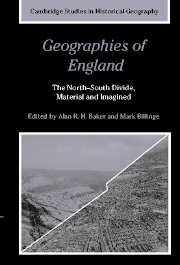Book contents
- Frontmatter
- Contents
- List of figures
- List of tables
- List of contributors
- Preface
- 1 Material and imagined geographies of England
- 2 The contemporary debate over the North–South divide: images and realities of regional inequality in late-twentieth-century Britain
- 3 Distressed times and areas: poverty, polarisation and politics in England, 1918–1971
- 4 Industry and identity: the North–South divide and the geography of belonging, 1830–1918
- 5 Divided by a common language: North and South, 1750–1830
- 6 South, North and nation: regional differences and consciousness in an integrating realm, 1550–1750
- 7 North–South dichotomies, 1066–1550
- 8 Cultural constructions of England's geography and history
- References
- Index
- Cambridge Studies in Historical Geography
4 - Industry and identity: the North–South divide and the geography of belonging, 1830–1918
Published online by Cambridge University Press: 10 December 2009
- Frontmatter
- Contents
- List of figures
- List of tables
- List of contributors
- Preface
- 1 Material and imagined geographies of England
- 2 The contemporary debate over the North–South divide: images and realities of regional inequality in late-twentieth-century Britain
- 3 Distressed times and areas: poverty, polarisation and politics in England, 1918–1971
- 4 Industry and identity: the North–South divide and the geography of belonging, 1830–1918
- 5 Divided by a common language: North and South, 1750–1830
- 6 South, North and nation: regional differences and consciousness in an integrating realm, 1550–1750
- 7 North–South dichotomies, 1066–1550
- 8 Cultural constructions of England's geography and history
- References
- Index
- Cambridge Studies in Historical Geography
Summary
At the beginning of the twentieth century the world's first industrial nation had achieved an unprecedented level of economic development, its economy wealthier and more powerful than ever, its people more populous and prosperous. Britain's workshops, forges and factories still accounted for a quarter of the world's manufacturing output. The country retained its pre-eminent commercial position as the universal merchant to the world. And it had extended its role at the heart of the global financial system, becoming not only the world's biggest trading nation but also its biggest lender. More trade was invoiced in sterling than in any other currency, and, perhaps most remarkably of all, British citizens owned more overseas assets than their counterparts in all the other developed economies combined. On the eve of the Great War, the British people were three or four times more productive than they had been at Victoria's accession to the throne. They were living longer, living better – again, on average, three times better – and evidently made the most of their greatly augmented earnings in a fully developed mass consumer society (Floud 1997).
Generations of scholars have nevertheless come to view the central problem of modern British history as one of economic failure (Supple 1994; Tomlinson 1996). ‘The principal question concerning the history of the British economy must … be why the rate of growth has always been so slow, performance so consistently mediocre’ (Lee 1986: 271).
- Type
- Chapter
- Information
- Geographies of EnglandThe North-South Divide, Material and Imagined, pp. 64 - 87Publisher: Cambridge University PressPrint publication year: 2004
- 4
- Cited by



